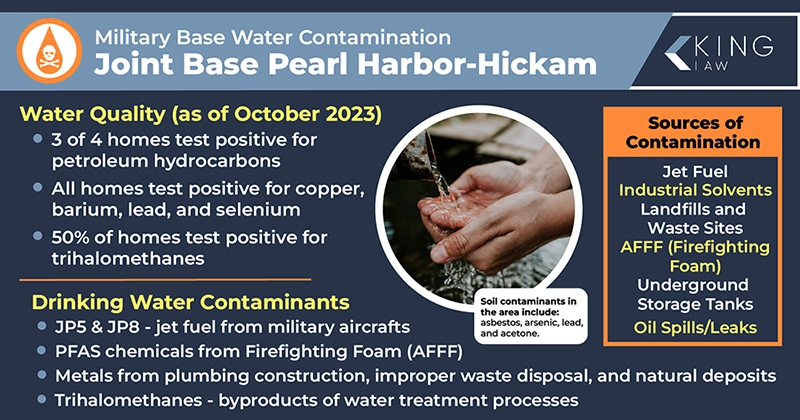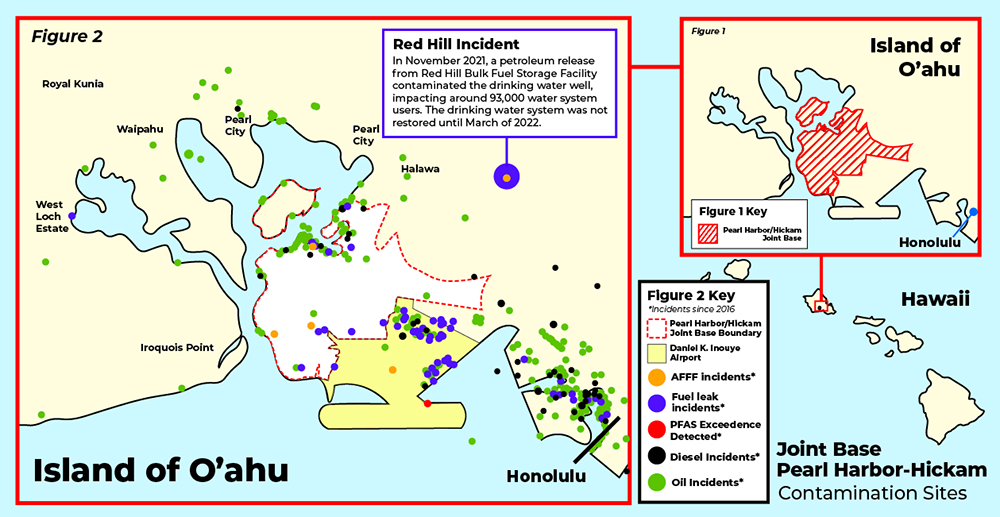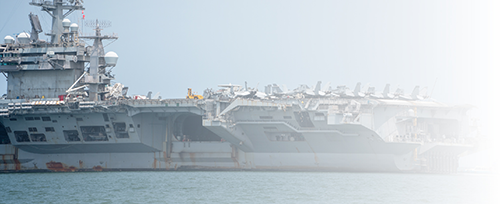
Pearl Harbor-Hickam Air Force Base Water Contamination Overview
In 2010, the United States Department of Defense (DoD), Base Realignment and Closure (BRAC), decided to combine Pearl Harbor and Hickam Field bases to form the Joint Base Pearl Harbor-Hickam (JBPHH). The base is located on the island Oahu, Hawaii and houses a reported 5,521 members of the Air Force along with their 7,652 family members.
Throughout JBPHH’s history, there have been many concerns regarding water quality. Various contaminants, including jet fuel, have entered the base’s drinking water, creating long-lasting health impacts for military members and their families. One of the largest Pearl Harbor water Contaminations occurred in November 2021, when 20,000 gallons of fuel, previously spilled at the Red Hill Bulk Fuel Storage Facility, were dumped into Pearl Harbor’s well water. Residents could see and smell gasoline in the water they used to cook, drink, clean, and bathe. Navy officials delayed telling residents about the spill and kept saying the water was safe to drink. As a result, many victims now have serious health problems and trauma from their experience.
Joint Base Pearl Harbor-Hickam Water Contamination Lawsuit Updates
Hundreds of victims continue to file lawsuits regarding Pearl Harbor-Hickam water poisoning. These lawsuits stem largely from the November 2021, water fuel event, but reported leaks span back to as early as 2014. Discover how events continue to unfold with the highlights below.
January 8, 2024 – Joint Base Pearl Harbor-Hickam Residents Continue to Experience Contaminated Water
Despite claims that drinking water is safe at JBPHH, residents continue to see oily film in their drinking water. Many are seeing symptoms identical to those from November 2021, such as stomach pain, heartburn, fatigue, headaches, and unusual rashes. Symptoms seem to emerge after drinking the water or even showering. Military personnel and their families, including small children, continue to express concern for their safety because of the contaminated water. The EPA tested water at four homes, three of which tested positive for petroleum hydrocarbons, that are commonly found in fuels such as diesel, at levels of 56 to 71.2 parts per billion (ppb). These results sit below the DOH’s screening level of 266 ppb, leaving residents both scared and frustrated.
January 2023 – Red Hill Clinic Opens to Treat Patients With Conditions Related to Water Contamination
More than a year after the initial leak, the United States Armed Forces and Defense Health Agency opened a clinic designated to treat victims of the water fuel contamination event. The Red Hill Clinic sees patients who were exposed to toxic water from November 21, 2021, through March 18, 2022, with symptoms such as upset stomach, stomach cramps, nausea, vomiting, diarrhea, and throat and mouth irritation. However, some victims may not get the care they need due to limited staffing and because they do not meet eligibility requirements.
December 2022-October 2023 – Ground Water Testing Shows PFAS Contamination
After the AFFF release, officials decided to conduct routine testing of the groundwater and soil at Pearl Harbor-Hickam AFB. Results are published online for public viewing and show a variety of positive results for PFAS contamination in the groundwater. Therefore, residents could be consuming water that has fuel and cancer-causing chemicals in it.
November 29, 2022 – 1,300 Gallons of Toxic Fire Suppressant Accidentally Released During Operation at Red Hill Bulk Fuel Storage Facility
In addition to the fuel, toxic fire suppressants were also released into the environment and further impacted the Joint Base Pearl Harbor-Hickam water quality. During routine operations, 1,300 gallons of Aqueous Film Forming Foam (AFFF), were unexpectedly released. AFFF is known to contain toxic cancer-causing chemicals, frequently recognized as PFAS.
October 26, 2022 – Water Issue Health Advisory Lifted for JBPHH
The Hawaii DOH lifted the health advisory put in place because of the Pearl Harbor water quality problems at Joint Base Pearl Harbor-Hickam. It stated: “All zones and service areas were safe for all potable water use including drinking, cooking, oral hygiene, and consumption by pets from the date the Public Health Advisories were amended and continue to be safe.”
August 31, 2022 – Plaintiffs File Contaminated Water Lawsuit Against the Government
In August 2022, victims of the Pearl Harbor contaminated water began to file lawsuits against the government under the Federal Tort Claims Act (FTCA). They claimed the Navy did not immediately disclose the fuel spillage and neglected to acknowledge the long-term effects of consuming the unsafe water. Hundreds of additional victims prepared to file claims with charges brought against the government for “negligence, nuisance, medical negligence, failure to treat, delayed care, and infliction of emotional distress.” Meanwhile, families had been experiencing issues like consistent migraines, gastrointestinal issues, neurological problems, and seizures.
March 18, 2022 – Pearl Harbor-Hickam Water Is Declared Safe to Drink
By mid-March 2022, officials declared the water at Pearl Harbor-Hickam AFB finally safe to drink. However, an estimated 93,000 people had been impacted across 9,715 households and 19 different communities. Victims included Navy, Army, and Air Force personnel, their families, and nearby Hawaiian civilians. Victims were experiencing an array of health issues, emotional distress, and financial concerns as they sought reassignment or struggled to move to a location with safe drinking water.
March 7, 2022 – Plans to Close Red Hill Bulk Fuel Storage Facility Are Announced
In early March, Secretary of Defense, Lloyed Austin, announced plans to close the Red Hill Bulk Fuel Storage Facility. These plans involved the removal and redistribution of 20 underground tanks of fuel. These tanks were constructed in the 1940s in an effort to support World War II efforts and are positioned 100 feet below ground. The timeline for removing the fuel and closing down the facility is expected to last several years and continues to be a work-in-progress today.
December 17, 2021 – Government Forms a Team for Pearl Harbor-Hickam Water Restoration
On December 17, 2021, the Hawaii Department of Health (DOH), announced their collaboration with the Environmental Protection Agency (EPA), the Navy, and the Army to form an Interagency Drinking Water System Team (IDWST), to begin water restoration efforts at Pearl Harbor-Hickam. Their goal was to ensure safe drinking water for Military personnel and their families stationed at the affected site.
November 28, 2021 – Military Families Smell and See Fuel in Their Tap Water
The Navy had initially told residents it was okay for them to drink and use their tap water. However, victims were experiencing abdominal pain, vomiting, memory loss, skin irritation, eye irritation, teeth concerns, gum issues, and other problems. They also began to notice a gas-like odor in their water and visible oily film. Claimants asserted that the Navy knew the Pearl Harbor water was poisoned but continued to tell residents it was safe to drink.
November 20, 2021 – Initial Fuel Spillage Enters Drinking Water
In November, the drooping line was hit by a train, causing the 20,000 gallons of fuel to spill into a nearby drain and a well of drinking water. Red Hill already had a long history of leaks and did not alert residents in a timely manner of the water contamination, extent of poisoning, or the associated health risks. Unfortunately, thousands of people used and drank the poisoned water at Pearl Harbor-Hickam. Many even began to experience symptoms of consuming soiled water well before November, which was likely due to previous leaks.
May 6, 2021 – Initial Fuel Leak From Worker’s Mistake
After careful investigation, officials confirmed an operator made a mistake when transferring fuel from one tank to another, causing approximately 20,000 gallons of fuel to spill in early May 2021. Most of the spillage went into a fire suppressant line that was left abandoned for six months until it began to droop. The Navy noted the amount of fuel that ended up in the drinking water “cannot be calculated, but is assessed to be small.”
January 2014 & January 2015 – 27,000 Gallons of Jet Fuel Spill, Sparking Government Action
In January 2014, Navy inspectors identified a jet fuel spillage of 27,000 gallons at Red Hill Bulk Fuel Storage Facility. This resulted in the 2015 Red Hill Administrative Order on Consent (AOC) where the government committed to helping address fuel spill concerns and infrastructure issues that contributed to the spill.
On this page:
The History of Water Contamination at Joint Base Pearl-Harbor Hickam AFB
Sources of Water Contamination at Hickam AFB
Current Water Quality at Pearl Harbor-Hickam Air Force Base
Joint Base Pearl Harbor-Hickam Water Contamination Map
Eligibility Criteria for Hickam AFB Water Contamination Lawsuit
Hickam AFB Water Contamination Settlement and Payout Amounts
The History of Water Contamination at Joint Base Pearl-Harbor Hickam AFB
The Red Hill Bulk Fuel Storage Facility has been the primary source of water contamination for decades. The facility is positioned just 100 feet above the island’s only groundwater aquifer that supplies drinking water to about 25% of the island. Civilians assert that there have been 73 fuel leaks at Red Hill with more than 180,000 gallons of fuel spilled. While the Navy disputes this claim, residents demand accountability as they experience what many legal professionals consider medical gaslighting.
Fuel was first identified in the Pearl Harbor-Hickam drinking water in November of 2021, though Hawaiins expressed concerns as far back as May 2014, with an earlier leak. Residents were finally heard in November 2021, when they could see and smell gasoline in the water coming out of their sinks and showers. They immediately began to experience horrible health effects that impacted their day-to-day lives. For many, symptoms have worsened since their initial contact with the contaminated water. Testing came back with petroleum levels 350 times higher than what is considered “safe” by government standards. Testing confirmed that the water at Pearl Harbor contained both jet fuel and other contaminants like metals and chlorine chemicals.
While officials have stood by their claim that the drinking water is safe, children and adults are experiencing life-hindering conditions from consuming and bathing in the current water. The water has tested positive for harmful chemicals like fuel and “forever chemicals” (PFAS), but because levels are below the legally imposed limits the issue remains unaddressed. Victims are fearful as they feel serious health risks from low amounts of contamination over long periods of time aren’t being taken seriously.
Sources of Water Contamination at Hickam AFB
The Red Hill Bulk Fuel Storage Facility is the primary source of water contamination at Hickam AFB. There have been a series of leaks over the past decade with one of the most notable spills taking place in May of 2021, when an operator error contributed to the spill of over 20,000 gallons of fuel, primarily into a nearby fire suppressant line. The line filled with fuel was then abandoned for approximately six months until it began to sag and was hit by a passing train. Around 20,000 gallons of fuel was then dumped into a nearby well of drinking water in November 2021–then spreading to thousands of nearby military and non-military homes.
Most recently, there have been concerns of PFAS contamination. PFAS represents a group of chemicals found in a fire suppressant foam called Aqueous Film Forming Foam (AFFF), that was used frequently at Hickam AFB. The levels of PFAS found in AFFF are known to cause certain types of cancers and other life-threatening illnesses. The fire suppressant foam chemical contamination also came from Red Hill despite government efforts to defuel and shut down the facility for good. With periodic testing taking place since November 2021, results have come back positive for not just fuel and PFAS, but also for metals and high levels of chlorine.
Current Water Quality at Pearl Harbor-Hickam Air Force Base
In response to JBPHH resident’s continued concerns about their water, the EPA collected five samples in October of 2023. The EPA released their findings in December and found:
- Three out of four homes tested positive for petroleum hydrocarbons ranging from 56-71.2 ppb. The testing method could not recognize levels below 50 ppb.
- All homes tested positive for barium, copper, lead, and selenium.
- Two homes tested positive for trihalomethanes used to disinfect.
Other groundwater testing also shows detection of various perfluoroalkyl and polyfluoroalkyl “forever chemicals” that do not break down in the environment and build up in the body. The EPA asserts no levels exceed their guidelines. However, victims of the water contamination feel the testing is flawed and should be done continuously and in real time. They also want recognition of the long-term risks associated with even low levels of exposure.

Contaminants and Chemicals Found in Hickam AFB’s Drinking Water
Contaminants and chemicals found in Pearl Harbor-Hickam’s water include:
- JP5 and JP8: Jet fuel used for military aircrafts, stored in Pearl Harbor fuel storage tanks that date back to World War II.
- PFAS: Toxic chemicals from a fire suppressant known as Aqueous Film Forming Foam (AFFF).
- Metals: Substances like barium, copper, lead, and selenium that enter the water from plumbing construction, improper waste disposal, and natural deposits.
- Trihalomethanes: Byproducts of water treatment processes that use chlorine as a disinfectant.
Officials have also identified contaminated soil at the Pearl Harbor superfund site with cancer-causing chemicals such as asbestos, arsenic, acetone, lead, and mercury, among many others. Site investigations back in the late 1900s also found that the soil and groundwater was contaminated with perchloroethylene (PCE), trichloroethylene (TCE), trichloroethylene (DCE), and vinyl chloride.
Joint Base Pearl Harbor-Hickam Water Contamination Map

Reference the above map to understand the extent of contamination at Joint Base Pearl Harbor-Hickam AFB. Utilizing the Key, you can see the different types of contaminants and how they have spread through drinking water from Red Hill throughout the base and nearby communities.
Health Risks Linked to Hickam Air Force Base’s Drinking Water
Victims of Hickam AFB’s water contamination have reported an array of symptoms and conditions after consuming and using the poisoned water. Linked health risks include:
- Changes to smell and taste
- Rashes and skin irritation
- Ongoing skin conditions
- Nausea and vomiting
- Upset stomach and stomach cramps
- Nosebleeds
- Headaches
- Diarrhea
- Excessive fatigue
- Dizzines
- Sinus issues including congestion
- Memory loss
- Neurological problems
- Gastrointestinal issues
- Respiratory problems
Our law firm is currently evaluating cases where individuals have been diagnosed with:
- Bladder Cancer
- Breast Cancer
- Kidney Cancer
- Leukemia
- Liver cancer
- Multiple-Myeloma
- Non-Hodgkin’s Lymphoma
- Pancreatic Cancer
- Prostate Cancer
- Testicular Cancer
- Thyroid Cancer
- Thyroid Disease
- Ulcerative Colitis
A study published in May 2022 surveyed 2,289 individuals with one or more household members participating from 14% of the estimated 9,694 households impacted by the fuel water contamination. Participants reported the following after the November 2021 water contamination incident:
- 87% had one new or worsened symptoms
- 75% had symptoms lasting at least 30 days
- 62% had nervous system-related symptoms
- 58% had gastrointestinal system-related symptoms
- 58% had skin-related symptoms
- 58% had ear-, nose-, and throat-related symptoms
- 46% had mental health-related symptoms
- 42% had eye-related symptoms
- 31% had respiratory system-related symptoms
- 37% sought medical care after the incident, some who were hospitalized overnight
- 80% had symptoms improve when swapping to alternate water source
Keep in mind: These reports are from just a fraction of those who were impacted by the unsafe water that was used to drink, cook, bathe, wash dishes, do laundry, and more.
Eligibility Criteria for Hickam AFB Water Contamination Lawsuit
Anyone impacted by the contaminated water at Hickam AFB should speak with an experienced lawyer to determine their eligibility to file a lawsuit. Many individuals filed under the Federal Tort Claims Act (FTCA), in a mass tort meant to hold the government accountable for the contamination catastrophe. Under the FTCA, claimants must have been a resident at or near the base during the time of contamination with related symptoms.
However, some individuals are suing out of fear that they will end up experiencing symptoms at a later date from their exposure to toxins in the water. Individuals should discuss their circumstances with an attorney before ruling out the possibility of a lawsuit.
Our law firm is currently evaluating cases where individuals have been diagnosed with:
- Bladder Cancer
- Breast Cancer
- Kidney Cancer
- Leukemia
- Liver cancer
- Multiple-Myeloma
- Non-Hodgkin’s Lymphoma
- Pancreatic Cancer
- Prostate Cancer
- Testicular Cancer
- Thyroid Cancer
- Thyroid Disease
- Ulcerative Colitis
Pearl Harbor-Hickam AFB Water Contamination Settlement and Payout Amounts
Actual payout amounts from water contamination lawsuits will vary based on the individual case, but are expected to be between $30,000 to $500,000. Claimants may receive more or less, depending on the duration of their exposure, amount of exposure, and the severity of illnesses or symptoms. Get in touch with an attorney to explain your circumstances and get a better understanding of your compensation potential.
Military Base Water Contamination Lawyers
With a history of handling environmental exposure and military-related cases, King Law attorneys are a great option for water contamination claims. King Law understands the burdens victims and their families face as a result of their exposure and is dedicated to fighting for them. Without choosing a reputable, experienced firm, claimants risk missing their opportunity to file a lawsuit and earn the full amount of compensation they deserve. Reach out as soon as possible to improve your chances of a successful case.
Frequently Asked Questions (FAQs)
If you’re seeking additional information regarding water contamination at Joint Base Pearl Harbor-Hickam AFB, keep reading for answers to some frequently asked questions.

